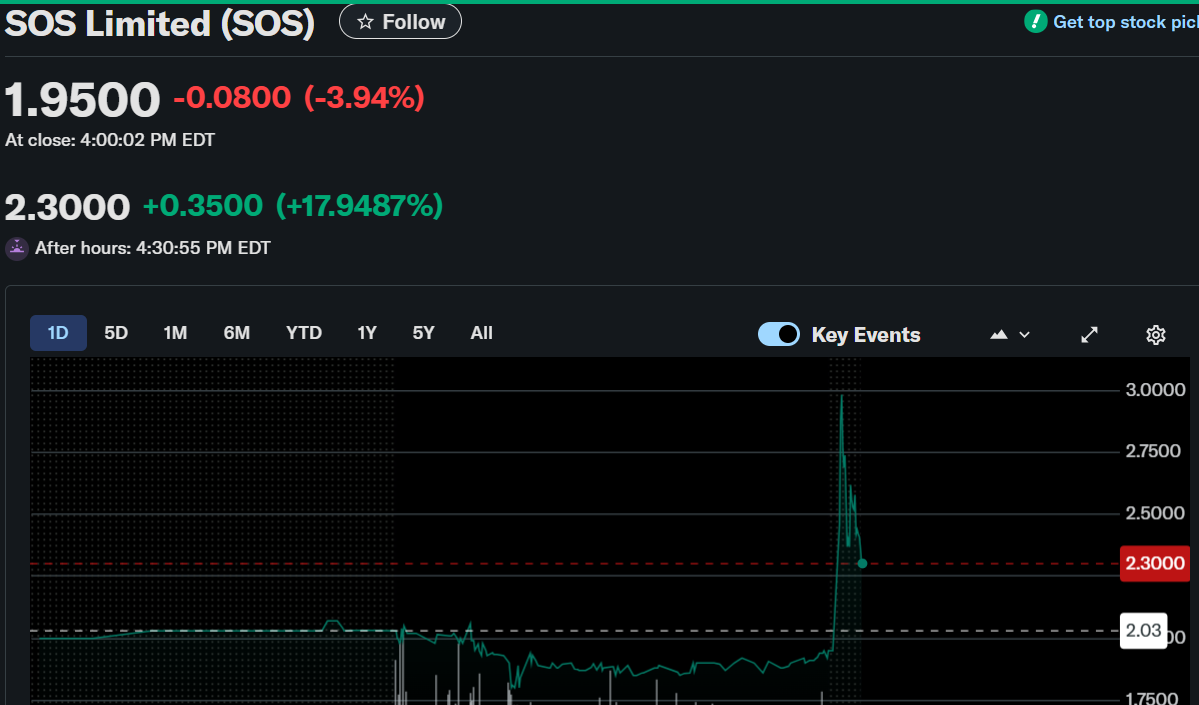SOS Limited (SOS) Stock: Revenue Surges 48%, But Net Loss and Cash Burn Raise Red Flags
TLDR
- SOS surges after hours despite widening losses and sharp cash depletion.
- SOS pivots to commodities; revenue up, but losses and cash risks grow.
- SOS earnings lift stock post-market as revenue jumps 48% on rubber sales.
- SOS revenue surges, but losses deepen and liquidity remains a concern.
- SOS stock rallies after hours on growth, despite cash crunch and losses.
SOS stock closed at $1.95 during regular trading on September 26, 2025, down 3.94% from the prior session. However, shares surged 17.95% after hours to $2.30 following the earnings release. The contrasting stock reaction reflects optimism around revenue growth but concern over losses and cash depletion.

SOS Limited (SOS
Revenue Growth Driven by Commodities Trading
SOS Limited reported semi-annual results for the six months ended June 30, 2025. The company achieved revenue of $89.6 million, reflecting a 48.1% increase from the prior year. Growth came mainly from higher natural rubber sales as demand in China recovered steadily.
The commodities trading segment contributed 94.9% of revenue, while hosting services delivered 4.3% and others provided 0.8%. The company shifted away from cryptocurrency mining operations to focus on hosting services. Management highlighted stronger demand for third-party hosting despite suspending self-mining.
Nevertheless, despite higher revenue, SOS faced a gross loss of $1.3 million, reversing a gross profit of $2.4 million in 2024. The gross margin stood at negative 1.5%, down from a positive 4% in the previous year. Falling rubber spot prices and losses from petroleum coke weighed heavily on profitability.
Losses Widen and Costs Escalate
The company recorded a GAAP net loss of $14.2 million, a 30.3% increase from last year’s $10.9 million. Operating costs surged 56.5% to $90.9 million, outpacing revenue growth and further pressuring margins. Selling expenses rose slightly to $2.3 million, mainly due to higher transportation costs.
General and administrative expenses dropped 35% to $9.4 million as mining machines were fully impaired and required no depreciation. However, this reduction did not offset the broader rise in costs across operations. The loss per share was $(0.0139), compared with $(0.0299) a year earlier.
The company sold petroleum coke inventory at cost and absorbed over $1.6 million in losses from rubber price declines. Management emphasized a strategy of pursuing market share over short-term profitability. Competitive pricing was prioritized to maintain trading volume amid challenging conditions.
Liquidity Risks and Strategic Investments
Cash and cash equivalents fell sharply to $4.2 million from $246.7 million a year earlier. The decline of 98.3% resulted mainly from a $228.4 million prepayment for blockchain commodity trading platform development. Management described the payment as a move to secure long-term value and secure critical partner resources.
During the reporting period, the company raised $6.8 million in net proceeds through a registered direct offering under Form F-3. Despite this, liquidity remains constrained, and further capital raising plans have been confirmed. The shift underscores the company’s ongoing dependence on external funding to sustain operations.
The post SOS Limited (SOS) Stock: Revenue Surges 48%, But Net Loss and Cash Burn Raise Red Flags appeared first on CoinCentral.
You May Also Like

Botanix launches stBTC to deliver Bitcoin-native yield

Shiba Inu Price Prediction: No All Time High In Sight – Whales Are Buying This New Crypto Instead
